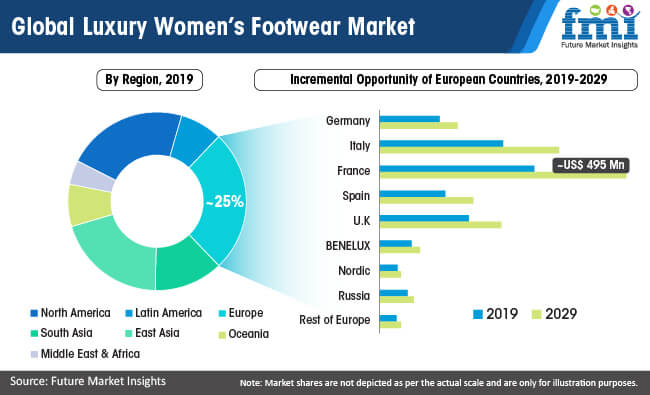The recent past has observed an increased in number of HNWI population in 2018. Globally, HNWI population reached 22.4 million, and their total wealth accounted for US$ 61,275 Bn in 2018. Europe accounted for high growth rate of HNWI population, with almost 5.6 Mn HNWI population. This leads to high purchasing power of individuals. In addition, growing working women population and women’s labor force participation in regions such as Japan, the United Kingdom, and France help increase their purchasing power to buy luxury footwear.
On the back of these factors, the women’s luxury footwear market is estimated to be valued at US$ 12 Bn in 2019, and expected to expand at a healthy CAGR during the forecast period of 2019-2019. In 2019, worldwide sales of women’s luxury footwear are mostly contributed by sandals and flats casual as compared to other categories (boots, heels & pumps, and casual, sneakers & sports shoes) in the market.

Key Takeaways – Women’s Luxury Footwear Market
- Europe is expected to remain prominent in the global women’s luxury footwear market, owing to high concentration of luxury footwear manufacturers such as JIMMY CHOO PLC, Hermes, Christian Dior, Gucci, Chanel, etc.
- The sandals & flats segment is considered as key attributor to the global women’s luxury footwear market, which can be attributed to their availability in wide variety of designs.
- High exposure of consumers in websites such as Amazon, Walmart, etc., with 10% online penetration rate, support online retail in becoming the most lucrative sales channel.
Increasing number of high-net-worth individuals (HNI) led to a surge in demand for custom footwear. Advancements in technology such as 3D printing and advanced sensors would also push manufacturers to introduce innovative shoe designs.
Top Trends in Women’s Luxury Footwear Market
The women’s footwear market contributes high market revenue share as compared to men’s. Changing lifestyle, growing fashion concern, and celebrity endorsement have a significant impact on the global footwear market. The recent market trends in luxury footwear are – sustainable footwear, smart shoes, and athleisure trends. Different types of prints with huge popularity in the past include animal print boots, florals print, minimalist style heels, feather heels, bright chunky sneakers, big toe sandals, etc.
Competitive Landscape Analysis
The report highlights some prominent players in the global women’s luxury footwear market, which include Kering, Burberry, Caleres, Jimmy Choo PLC, and others. Market players primarily focuses on product design and innovation. Maison Baum, a Germany-based luxury footwear manufacturer, launched a pain free high heel in Q1 2019. The company uses its patented footbed technology and an insole with anatomical elevations to shift wearers’ weight from the ball of the foot.
More Insights on Women’s Luxury Footwear Market
Future Market Insights, in its new offering, provides an analysis of the global women’s luxury footwear market, presenting historical demand data (2014-2018) and forecast statistics for the period of 2019-2029. The women’s luxury footwear market study reveals compelling insights on the basis of product (boots, heels & pumps, sandals & flats, casual, sneakers & sports shoes), material (rubber, leather, polyester, velvet, canvas, textiles, and others), price range (US$) (300-499, 500-699, 700-999, 1000-1299, 1300-1599, 1600 & Above), and sales channel (online and offline [department stores, specialty stores, monobrand stores, off-price stores, others]), across seven major regions.
Table Of Content
1. Executive Summary
1.1. Global Market Outlook
1.2. Summary of key findings
1.3. Summary of Key Statistics
1.4. FMI Analysis and Recommendations
2. Market Overview
2.1. Market Taxonomy
2.2. Market Definition
3. Key Market Trends
3.1. Key Trends Impacting the Market
3.1.1. Rapidly Growing Fashion Trend Particularly Among Young Professional Women
3.1.2. Rise In Female Participation In Workforce
3.1.3. Consumers Selecting for At-Home Services, Using e-Commerce
3.1.4. Luxury Brands Shift Their Attention To Asia
3.1.5. Introduction of Innovative Products With Multiple Features
3.1.6. Companies are Outsourcing Their Production To Low-Cost Labour Countries
3.1.7. Demand For Functional Footwear
3.1.8. Growing Trend of Mass Customization and Personalization
3.1.9. Emergence of High End & Luxury Footwear
3.2. Product Development Trends
3.3. Future Prospects of Footwear Industry
3.3.1. Factors Fuelling Growth
3.3.2. Influx of Brands
3.3.3. Increasing Demand of Athletic Shoes
3.3.4. Innovative Distribution & Digital Marketing Strategies
